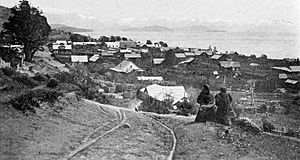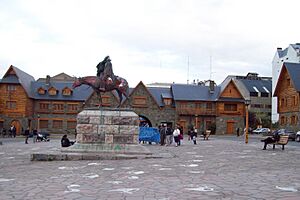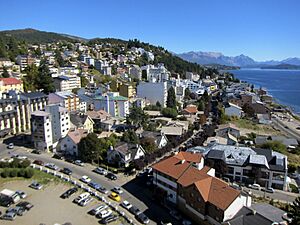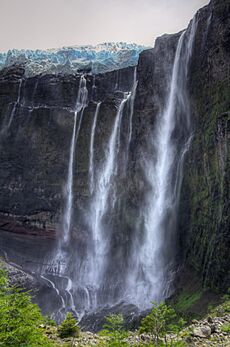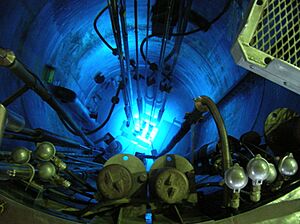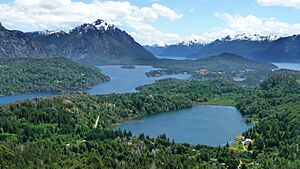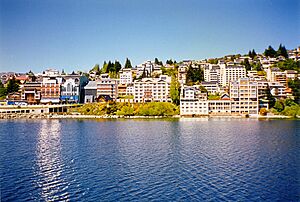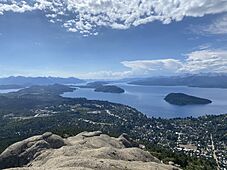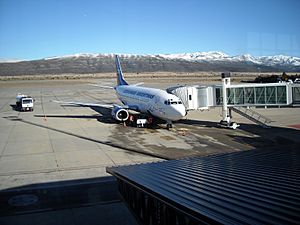Bariloche facts for kids
Quick facts for kids
San Carlos de Bariloche
Bariloche
|
|
|---|---|
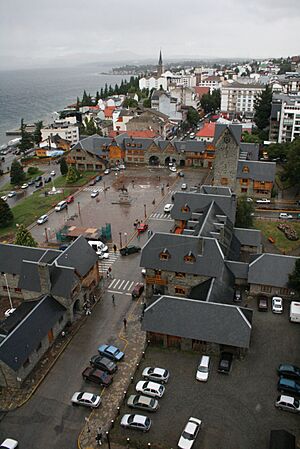
The Civic Center and port
|
|
| Country | |
| Province | |
| Department | Bariloche |
| Established | 1902 |
| Area | |
| • City | 220.27 km2 (85.05 sq mi) |
| Elevation | 893 m (2,930 ft) |
| Population
(2010 census)
|
|
| • Urban | 108,205 |
| • Metro | 130,000 |
| Time zone | UTC−3 (ART) |
| Climate | Csb |
San Carlos de Bariloche, often called Bariloche, is a city in the Río Negro area of Argentina. It sits at the base of the Andes mountains, right on the southern shore of Nahuel Huapi Lake. The city is also inside the Nahuel Huapi National Park. In the 1930s and 1940s, after lots of building and adding Alpine-style architecture, Bariloche became a popular place for tourists. People come here for skiing, trekking, and mountaineering. The city also has many restaurants, cafés, and chocolate shops. In 2010, about 108,205 people lived there. By 2020, it was estimated that the population grew to over 135,000.
Contents
History of Bariloche
The name Bariloche comes from the Mapudungun language, where Vuriloche means "people from behind the mountain." The Poya people used a secret mountain pass called Vuriloche to cross the Andes for a long time.
Long before European explorers arrived, native groups like the Tehuelches and Puelches lived by Lake Nahuel Huapi, where Bariloche is now. Over time, their culture was influenced by the Mapuches, who moved into the area more and more from the 1600s. By the late 1800s, only a few native families remained in the Nahuel Huapi area. Their lands had been taken, and their way of life changed.
The region then started to connect more with Chile than with the distant city of Buenos Aires. By the end of the 1800s, people from southern Chile, including farmers from Chiloé Island and German immigrants, began to settle around the lake.
Early Explorations and Missions
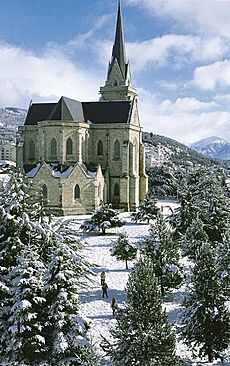
Spanish explorers knew about Nahuel Huapi Lake since the 1500s. In 1552–1553, Francisco de Villagra, sent by the Spanish Governor of Chile, explored the area east of the Andes and reached the Limay River near the lake.
Later, in 1650, a Jesuit priest named Diego de Rosales visited the lake. He was sent by the Governor of Chile to help with unrest among the native Puelche and Poya people. In 1670, another Jesuit priest, Nicolás Mascardi, started a mission at Nahuel Huapi Lake, but it only lasted until 1673. A new mission was set up in 1703, supported by money from Potosí. This mission was stopped in 1717 after a disagreement with the Poya people. In 1767, all Jesuit missions in the Americas were closed.
From the 1800s to the Early 1900s
For much of the 1800s, the Bariloche area had stronger ties to Chile. However, explorations by Francisco Moreno and Argentina's "Conquest of the Desert" campaigns helped Argentina claim the area. In the 1881 border treaty, Nahuel Huapi was officially recognized as part of Argentina.
German settlers began arriving in southern Chile in the 1840s. Some of them started a successful leather trade with native communities across the Andes. When the Argentine Army moved into the area in the 1880s, this trade was disrupted. Chilean merchants then had to cross the Andes themselves to get supplies. Many Chilean business owners, often with German backgrounds, set up cattle and trade businesses around Nahuel Huapi Lake.
How Bariloche Became a Modern Town
In the winter of 1894-1895, Carlos Wiederhold, a German-Chilean from Osorno, Chile, crossed the Andes to Nahuel Huapi Lake. He opened a small shop called La Alemana (The German) in 1895. This shop was the beginning of modern Bariloche. By 1900, Chilean merchants largely controlled trade in the area. A border agreement in 1902 between Chile and Argentina helped improve trust along the border. The trade route from Puerto Montt in Chile to Nahuel Huapi Lake remained very important for many years.
Chilean business owners also started cattle farms around the lake. They sent meat to central Chile and brought workers from southern Chile, especially from Chiloé Island. In the 1930s, the center of Bariloche was redesigned to look like a traditional European alpine town, earning it the nickname "Little Switzerland." Many buildings were built using wood and stone. In 1909, Bariloche had 1,250 people, a telegraph, a post office, and a road connecting it to Neuquén. Trade mostly depended on Chile until the railroad arrived in 1934, linking the city to markets in Argentina.
Building and Tourism Growth
Between 1935 and 1940, the Argentine Directorate of National Parks built many public works in Bariloche, giving the city its special architectural style. The Civic Centre is one of the most famous examples.
Bariloche changed from a cattle trading hub to a major tourist destination for people from Argentina and other countries. Tourism started growing in the 1930s. In 1934, Ezequiel Bustillo, who was in charge of National Parks, hired his brother Alejandro Bustillo to design buildings in Nahuel Huapi National Park. They believed the park's climate could compete with European tourist spots.
Alejandro Bustillo designed several important buildings, including the Neo-Gothic San Carlos de Bariloche Cathedral and the Llao Llao Hotel. Architect Ernesto de Estrada designed the Civic Centre of Bariloche, which opened in 1940. The Civic Centre buildings, made of tuff stone, slate, and Fitzroya wood, include the library, the Francisco Moreno Museum of Patagonia, City Hall, the Post Office, the Police Station, and the Customs office.
The Huemul Project
During the 1950s, on a small island called Huemul in Lake Nahuel Huapi, former president Juan Domingo Perón tried to secretly build the world's first fusion reactor. The project was very expensive, costing about $300 million in today's money, but it was never finished because the technology needed was too advanced. An Austrian scientist named Ronald Richter led the project. You can still visit the remains of the facilities today.
Tourism in Bariloche
Tourism is the most important activity in Bariloche all year round. The city is very popular with visitors from Brazil, Europe, and Israel. One of the most popular things to do is skiing, and most tourists come to Bariloche in winter (June–September). You can fly to Bariloche from Buenos Aires and other places.
The main ski slopes are at Cerro Catedral, which is the biggest ski resort in South America. In the summer, people enjoy beautiful beaches like Playa Bonita and Villa Tacul. Some brave swimmers even go into the cold lake waters, which are cooled by melting snow. Lake Nahuel Huapi is usually around 14°C (57°F) in summer.
Bariloche is the largest city in a big Lakes District and is a great starting point for many trips in the region. Popular activities include fishing, whitewater rafting, and birdwatching. You can also go trekking on trails in the nearby mountains, where there are mountain huts run by the Club Andino Bariloche. The city is famous for its delicious chocolates and Swiss-style buildings. Many high school students in Argentina take their senior trip to Bariloche, and the town is well-prepared to host these groups. In 2012, Bariloche was named the "national capital of adventure tourism" by Argentina's government.
Science and Technology
Besides tourism, Bariloche is also a center for advanced science and technology. The Centro Atómico Bariloche is a research center where scientists study many areas of physics. This complex also has the Instituto Balseiro, a special university that accepts a small number of students. The institute offers degrees in Physics and Nuclear, Mechanical, and Telecommunications Engineering.
The city is also home to INVAP, a high-tech company that designs and builds things like nuclear reactors, advanced radars, and space satellites. The Bariloche Foundation, a private group, also supports scientific research and teaching. There are also several science departments and labs at the National University of Comahue.
Geography and Climate
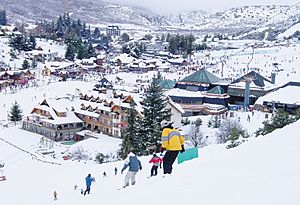
Bariloche is located where a cool Mediterranean climate meets an Oceanic climate, with features of a mountain climate. This means it has cool nights, big temperature changes, and strong winds. The amount of rain changes a lot depending on where you are. In the mountains, it can get 4000 mm (157 inches) of rain a year, but in the city, it's usually between 800 to 1,000 mm (31 to 39 inches). Most of the rain falls in autumn and winter.
The average yearly temperature in Bariloche is about 8.4°C (47°F). In January (summer), daytime temperatures are usually between 20 to 28°C (68 to 82°F) and can sometimes reach 30°C (86°F). In winter, daytime temperatures are between 1 to 8°C (34 to 46°F), and nights are often at or below freezing. Temperatures get colder as you go higher up the mountains.
It's often windy in Bariloche, with winds mostly coming from the west. These winds can be very strong, especially in spring, sometimes over 100 km/h (62 mph). In winter, when it's cold enough, it snows. The lakes are always cold, usually between 12 to 15°C (54 to 59°F), because they are large and deep. Smaller lakes in higher areas can freeze in winter.
| Climate data for San Carlos de Bariloche Airport (1991–2020, extremes 1951–present) | |||||||||||||
|---|---|---|---|---|---|---|---|---|---|---|---|---|---|
| Month | Jan | Feb | Mar | Apr | May | Jun | Jul | Aug | Sep | Oct | Nov | Dec | Year |
| Record high °C (°F) | 36.4 (97.5) |
35.4 (95.7) |
34.4 (93.9) |
26.3 (79.3) |
22.6 (72.7) |
19.4 (66.9) |
16.7 (62.1) |
19.6 (67.3) |
23.0 (73.4) |
29.1 (84.4) |
32.5 (90.5) |
33.9 (93.0) |
36.4 (97.5) |
| Mean daily maximum °C (°F) | 23.2 (73.8) |
23.1 (73.6) |
20.1 (68.2) |
15.0 (59.0) |
10.6 (51.1) |
7.2 (45.0) |
6.7 (44.1) |
8.4 (47.1) |
11.6 (52.9) |
14.7 (58.5) |
17.9 (64.2) |
20.7 (69.3) |
14.9 (58.8) |
| Daily mean °C (°F) | 15.4 (59.7) |
15.0 (59.0) |
12.1 (53.8) |
8.1 (46.6) |
5.2 (41.4) |
3.0 (37.4) |
2.1 (35.8) |
3.1 (37.6) |
5.2 (41.4) |
7.9 (46.2) |
10.9 (51.6) |
13.5 (56.3) |
8.5 (47.3) |
| Mean daily minimum °C (°F) | 7.0 (44.6) |
6.6 (43.9) |
4.9 (40.8) |
2.4 (36.3) |
1.0 (33.8) |
−0.5 (31.1) |
−1.6 (29.1) |
−1.0 (30.2) |
−0.1 (31.8) |
1.7 (35.1) |
3.9 (39.0) |
5.9 (42.6) |
2.5 (36.5) |
| Record low °C (°F) | −5.7 (21.7) |
−6.9 (19.6) |
−10.0 (14.0) |
−11.1 (12.0) |
−11.4 (11.5) |
−21.1 (−6.0) |
−25.4 (−13.7) |
−17.4 (0.7) |
−17.3 (0.9) |
−10.7 (12.7) |
−7.0 (19.4) |
−8.5 (16.7) |
−25.4 (−13.7) |
| Average precipitation mm (inches) | 23.6 (0.93) |
17.5 (0.69) |
29.4 (1.16) |
57.1 (2.25) |
113.7 (4.48) |
168.3 (6.63) |
126.4 (4.98) |
117.3 (4.62) |
55.4 (2.18) |
48.7 (1.92) |
30.1 (1.19) |
25.0 (0.98) |
812.5 (31.99) |
| Average snowfall cm (inches) | 0.0 (0.0) |
0.5 (0.2) |
0.0 (0.0) |
3.4 (1.3) |
7.0 (2.8) |
32.4 (12.8) |
41.7 (16.4) |
22.9 (9.0) |
6.2 (2.4) |
5.8 (2.3) |
0.2 (0.1) |
0.0 (0.0) |
120.1 (47.3) |
| Average precipitation days (≥ 0.1 mm) | 3.5 | 3.3 | 6.0 | 7.9 | 13.0 | 15.9 | 14.4 | 13.5 | 9.0 | 8.2 | 5.5 | 4.8 | 105.0 |
| Average snowy days | 0.0 | 0.1 | 0.0 | 0.5 | 1.3 | 5.1 | 5.9 | 4.4 | 2.0 | 1.6 | 0.3 | 0.1 | 21.3 |
| Average relative humidity (%) | 51.9 | 53.3 | 60.2 | 68.2 | 76.0 | 79.1 | 78.0 | 74.9 | 66.9 | 61.5 | 56.6 | 53.6 | 65.0 |
| Mean monthly sunshine hours | 334.7 | 283.3 | 241.6 | 183.7 | 130.4 | 96.0 | 124.7 | 146.9 | 189.9 | 239.3 | 290.7 | 296.3 | 2,594.6 |
| Percent possible sunshine | 75 | 72 | 65 | 56 | 45 | 39 | 40 | 47 | 54 | 61 | 71 | 72 | 58 |
| Source 1: Servicio Meteorológico Nacional (July record low, February record high) | |||||||||||||
| Source 2: Instituto Nacional de Tecnología Agropecuaria (rain and snow data 1951–1990), World Meteorological Organization (sunshine hours 1981–2010), NOAA (percent sun 1961–1990), | |||||||||||||
| Climate data for San Carlos de Bariloche (city centre) 1901–1950 | |||||||||||||
|---|---|---|---|---|---|---|---|---|---|---|---|---|---|
| Month | Jan | Feb | Mar | Apr | May | Jun | Jul | Aug | Sep | Oct | Nov | Dec | Year |
| Record high °C (°F) | 35.3 (95.5) |
35.5 (95.9) |
30.0 (86.0) |
24.7 (76.5) |
22.7 (72.9) |
19.0 (66.2) |
18.0 (64.4) |
19.1 (66.4) |
22.5 (72.5) |
27.2 (81.0) |
32.0 (89.6) |
33.5 (92.3) |
35.5 (95.9) |
| Mean daily maximum °C (°F) | 20.8 (69.4) |
20.6 (69.1) |
17.8 (64.0) |
13.9 (57.0) |
9.9 (49.8) |
6.9 (44.4) |
6.5 (43.7) |
7.8 (46.0) |
10.3 (50.5) |
13.8 (56.8) |
15.4 (59.7) |
18.1 (64.6) |
13.5 (56.3) |
| Daily mean °C (°F) | 14.4 (57.9) |
14.2 (57.6) |
11.8 (53.2) |
8.7 (47.7) |
5.7 (42.3) |
3.7 (38.7) |
3.0 (37.4) |
3.6 (38.5) |
5.4 (41.7) |
8.2 (46.8) |
10.2 (50.4) |
12.2 (54.0) |
8.4 (47.1) |
| Mean daily minimum °C (°F) | 8.2 (46.8) |
8.1 (46.6) |
6.3 (43.3) |
4.0 (39.2) |
2.1 (35.8) |
0.5 (32.9) |
−0.3 (31.5) |
0.0 (32.0) |
1.1 (34.0) |
3.0 (37.4) |
4.8 (40.6) |
6.6 (43.9) |
3.7 (38.7) |
| Record low °C (°F) | −0.1 (31.8) |
−0.7 (30.7) |
−4.0 (24.8) |
−7.8 (18.0) |
−7.8 (18.0) |
−18.0 (−0.4) |
−11.8 (10.8) |
−10.9 (12.4) |
−7.8 (18.0) |
−5.6 (21.9) |
−4.7 (23.5) |
−0.6 (30.9) |
−18.0 (−0.4) |
| Average precipitation mm (inches) | 31.2 (1.23) |
29.3 (1.15) |
61.7 (2.43) |
82.2 (3.24) |
173.4 (6.83) |
200.8 (7.91) |
167.8 (6.61) |
129.0 (5.08) |
83.1 (3.27) |
43.0 (1.69) |
51.9 (2.04) |
43.1 (1.70) |
1,096.5 (43.17) |
| Average relative humidity (%) | 62 | 64 | 67 | 73 | 80 | 82 | 81 | 78 | 72 | 68 | 67 | 65 | 72 |
| Source 1: Instituto Nacional de Tecnología Agropecuaria | |||||||||||||
| Source 2: Secretaria de Mineria (extremes 1901–1950) | |||||||||||||
The ground beneath Bariloche is made up of layers of rock and soil left behind by glaciers during the last Ice Age.
Plants and Trees
Bariloche is in a special area where the dry Patagonian steppe meets the green Valdivian forest. This means it has many different kinds of native plants and trees, including:
- Fitzroya cupressoides, also known as Alerce
- Drimys winteri, called Canelo
- Lomatia hirsuta, known as Radal
- Nothofagus nervosa, or Raulí
- Nothofagus dombeyi, called Coihue
- Nothofagus betuloides, or Coihue de Magallanes
- Nothofagus antarctica, known as Ñire
- Nothofagus pumilio, or Lenga
- Nothofagus obliqua, called Roble Pellín
- Chusquea culeou, or Caña Colihue (a type of bamboo)
- Maytenus boaria, known as Maitén
- Austrocedrus chilensis, or Ciprés (cypress)
- Luma apiculata, called Arrayán
- Embothrium coccineum, or Notro
- Araucaria araucana, also known as Araucaria
- Gevuina avellana, or Avellano
- Alstroemeria aurea, called Amancay (a flower)
- Fuchsia magellanica, or Chilco (a flower)
Getting Around Bariloche
Bariloche has an international airport (IATA BRC/ICAO SAZS) that can handle all types of planes. Many important airlines in Argentina have regular flights to Bariloche, and some international flights come from nearby countries, especially during ski season.
You can also reach the city by train. The Tren Patagonico connects Bariloche with the city of Viedma, crossing Argentina from the Andes to the Atlantic Ocean.
By road, you can get to Bariloche by bus or car. The main roads from the North are RN 40, which comes from Villa La Angostura and Mendoza, and RN 237, which connects to Neuquén and other parts of Argentina. From the East, you can take RN 23, and from the South, RN 40 from El Bolsón.
Bariloche is also close to the border with Chile. You can cross into Chile through the Cardenal Antonio Samoré Pass, which is about 125 km (78 miles) northwest of Bariloche.
Buses in the City
Inside Bariloche, Mibus is the main bus company for public transport. You use a special SUBE card to pay for rides. Another company, Las Grutas, connects Bariloche with Dina Huapi and also runs through parts of the city.
Military Presence
Bariloche is home to the army's "12° Regimiento de Infantería de Montaña" (12th Mountain Infantry Regiment). Here, soldiers learn how to operate in mountain conditions, including combat, survival, and skiing. Soldiers from other parts of Argentina often come here for training. The Escuela Militar de Montaña, which is the mountain warfare school for the Argentine Army, is also located in Bariloche.
Neighborhoods
The main neighborhoods in Bariloche include Belgrano, Jardín Botánico, Melipal, Centro, Las Victorias, Las Marias, Dos Valles, and Playa Bonita.
City Landfill and Environment
The city of Bariloche has a large landfill that has been identified as a concern for the natural environment. This landfill is located near neighborhoods with many people living in them. There have been ongoing requests to move the dump. Fires at the landfill are also common, affecting nearby homes, forests, and wildlife. The water that collects in the landfill can also affect the lake, which is a source of drinking water for local residents.
Sports
The Andean Club Bariloche (Club Andino Bariloche-CAB) helped organize the 1st and 3rd South American Ski Mountaineering Championships.
The Club Deportivo Cruz del Sur is a local football (soccer) team that plays in a lower Argentine league. Other local teams like Estudiantes Unidos and Estrella del Sur also play in similar leagues.
Sister Cities
Bariloche is connected with other cities around the world, which are called "sister cities." These connections help promote cultural exchange and friendship. Bariloche's sister cities are:
 Aspen, United States
Aspen, United States L'Aquila, Italy
L'Aquila, Italy Osorno, Chile
Osorno, Chile Puerto Montt, Chile
Puerto Montt, Chile Puerto Varas, Chile
Puerto Varas, Chile Purranque, Chile
Purranque, Chile St. Moritz, Switzerland
St. Moritz, Switzerland Queenstown, New Zealand
Queenstown, New Zealand
Images for kids
See also
 In Spanish: San Carlos de Bariloche para niños
In Spanish: San Carlos de Bariloche para niños



